Most kids on my street had pet dogs, cats, rabbits, hamsters and a host of other furry friends. My pets were, with the exception of a guinea pig of two, of an altogether more slippery kind – amphibians. It started with frogs from the local pond, progressed to salamanders and other European amphibians, and eventually, the jewel in the crown, the Green and Black Poison Dart Frog.
These paint explosion of metallic green seemed like one of nature’s most exotic secrets, so the chance of seeing one in the wild rainforests of Central America was almost unimaginable. These tiny gems were top of my wish list when I booked a trip to Panama. I even wrestled for a macro lens for my camera on eBay just in case a little hopper crossed my path.

The first few days of the holiday found us staying on a small island on the Pacific coast of Panama. Isla Muertos has one holiday house on an otherwise uninhabited island. From research I knew there would be poison dart frogs in the area, as well as a host of other wildlife. What I wasn’t prepared for was the number of frogs that lived around the house. My expectation of long, sweaty hikes slashing through vindictive rainforests, lashing at my flesh with thorns, stinging plants and biting insects turned out to be entirely unnecessary. I didn’t need to go to the frogs because the frogs came to me.

The Green and Black poison dart frog, in common with most of the poison dart family, is a small brightly coloured frog. I have read that it grows up to 4 cm (1.57 inches) in length, but I have not seen one, wild or captive, over 3 cm (1.18 inches). This frog is only active during the day time, but has no need for camouflage. Quite the opposite is true, as it sports a striking coat of vibrant, swirling metallic green, which serves as a warning to potential predators. Ignore this warning at your peril, for this is one of the most poisonous creatures on the planet.
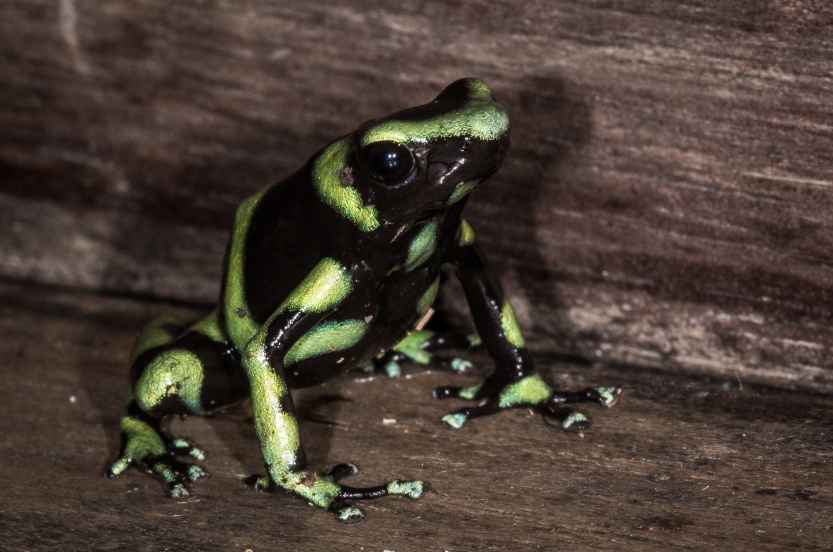
Some of the photos that I have published here look like they were taken in an aquarium. You can see smooth wooden planks and a frog against the glass. But these are all wild frogs. Early in the morning, or after one of the daily downpours, a few of the more adventurous frogs would hop up on to the deck to explore. This included an inspection of the windows and doors. Their presence on the raised deck gave me a great chance to climb down to the ground and position myself at eye level with them.
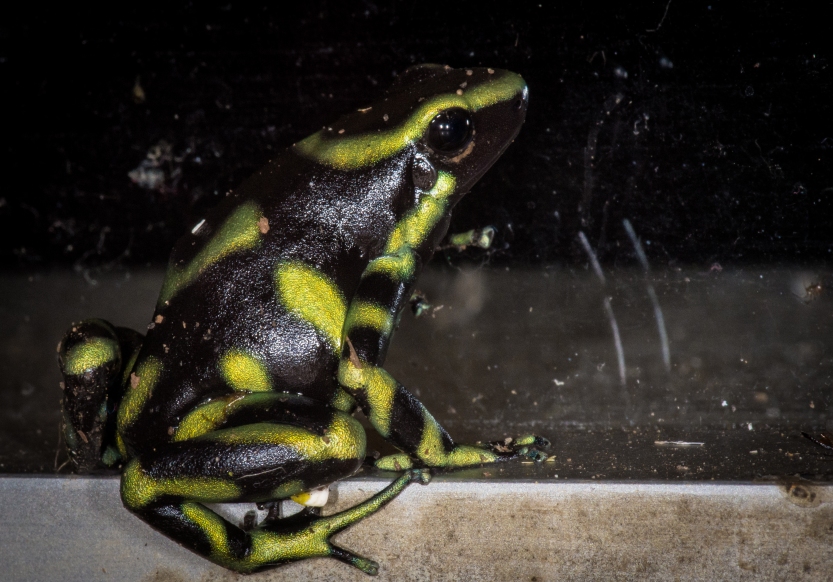
The nightly routine before heading to bed was to take out the trash to the outside garbage bin. I didn’t want the ants to come in for the pineapple peel. One night we had a visitor. No doubt it was one of those masked bandits, raccoons, that pulled over the garbage can, dragged the torn liner and its contents over the yard. At first light my bleary eyed disappointment soon turned to amazement as I realized that the strewn trash was surrounded by a bubbling, bouncing army of frogs. The ants had come and so to had the fruit flies, and where there are ants and fruit flies the frogs will surely follow.
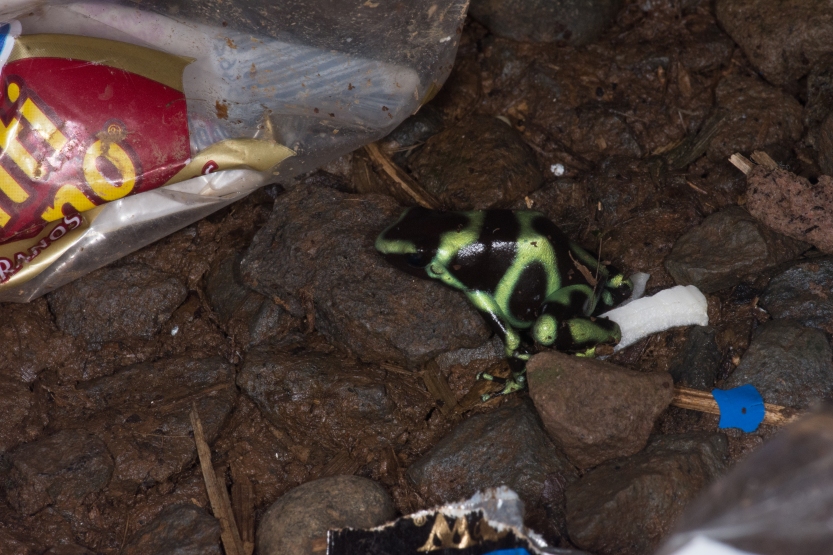
Perhaps this moment did take little of the exotic mysticism away. I anticipated a rare encounter with a timid little emerald, peeping out from the jungle leaf litter. Instead I got a pack of scavengers boldly gathered around a raccoon demolished trash can. This isn’t what you read about in books and it isn’t what David Attenborough shows you on the television.
The frog’s diet is largely made up of tiny jungle ants as well as other pin-head sized invertebrates. The body of these ants contains small amounts of alkaloids. It is these alkaloids that the dart frog converts to the deadly skin secretion that gives it its name. Dart frogs kept in captivity lose their toxicity over time as the aquarium diet of fruit flies and micro-crickets does not provide the raw ingredients required to create their killer soup.
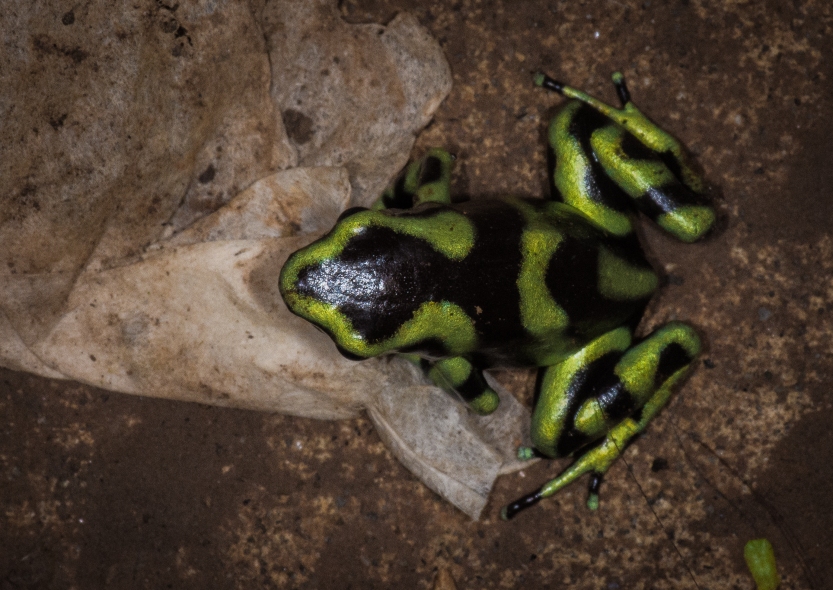
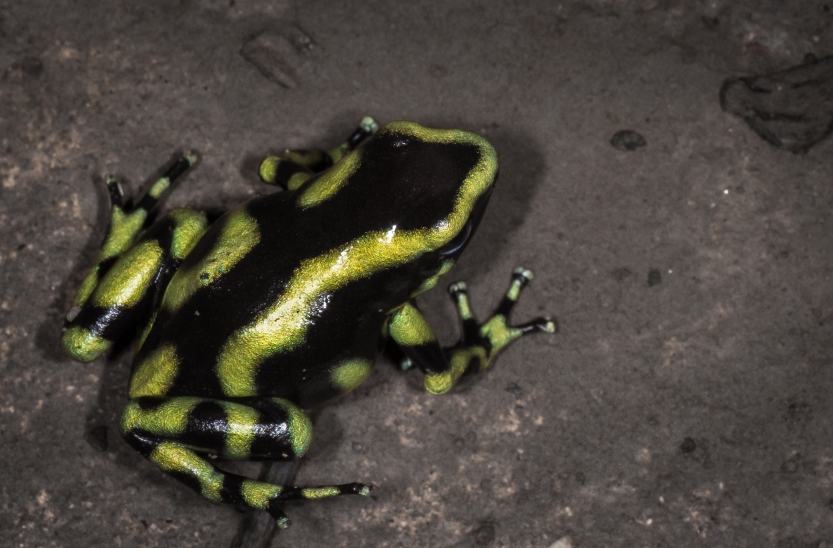
Humans have been tied in a close relationship with this lethal little hopper for many centuries. The tribes of the Central American rainforests collect them to extract the powerful poison from the skin. This poison is smeared onto dart tips and used in blow-pipes to shoot canopy animals during bush meat hunts. The toxic brew is so powerful that a monkey shot with such a dart will fall dead from a tree in moments. The Green and Black dart frog is by no means the most poisonous of the dart frogs, but it is powerful enough to stop your heart from beating in minutes.
The deadly nature of poison dart frog’s skin is generally well known. Perhaps less well known is the research that has been taking place over recent years in to the benefits to humanity that could be hiding in those deadly alkaloids. Pharmaceutical companies are currently studying a painkiller found in the skin of the Green and Black poison dart frog that is 200 times more potent than morphine, with no side effects of addiction.
This frog is not currently listed as endangered, but the devastation that we continue to inflict on the world’s rainforests is well documented. As we lose these treasure troves, we lose the jewels that live within. In our thirst for instant rewards of land and timber we may be destroying the creatures that hold the key to the survival of our species. Painkillers, new antibiotics, maybe a cure for cancer may all be hiding in a tiny, jewel encrusted frog’s back, waiting to be found.
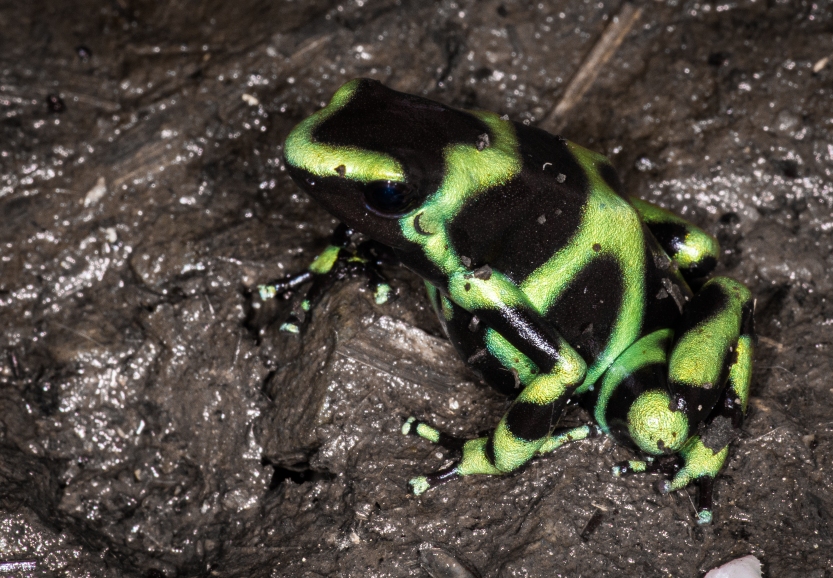
For my part, I’m less concerned with what hides in their remarkable little jackets. It was my privilege was to spend time on the deck of a rainforest cabin, with a smile tattooed across my face, in the company of these bold little jungle gems. This was a bucket-list encounter for me, even as I was picking them out of the garbage. It was in fact, a dream come true!
Join the conversation below. Have you encountered poison dart frogs? What is your dream wildlife encounter?
Connect others with wildlife by sharing this post on your social media accounts. If you enjoyed this post, follow Incidental Naturalist.
Categories: Central America
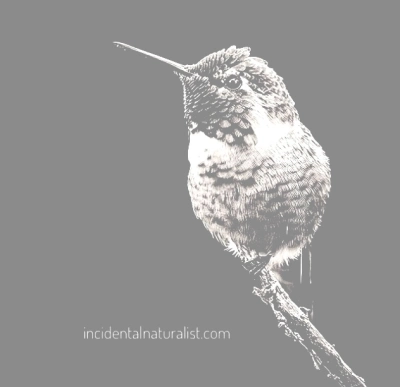


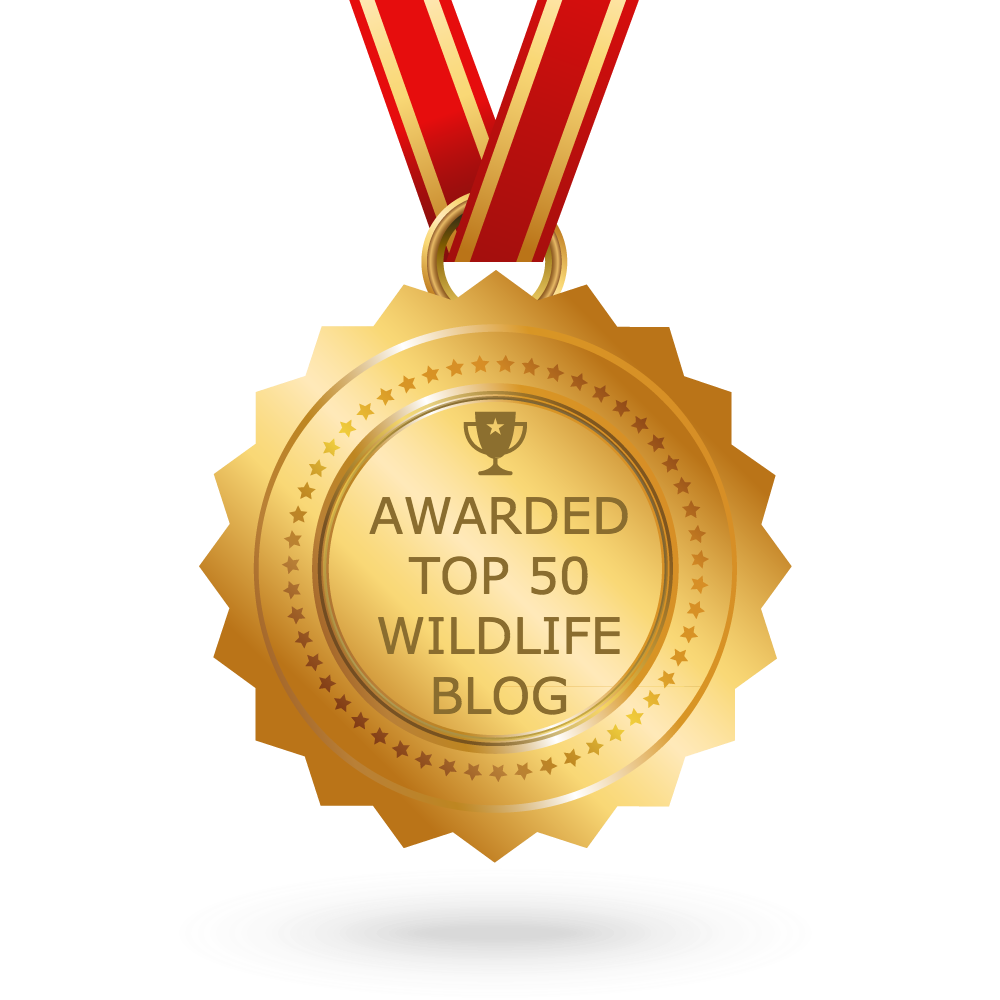

Great post, David. This is what the true nature adventures are all about: we find the native creatures in all places, sometimes expected, and often not. Living in the true forest on your trip, instead of the resorts that are sprayed and lit and void of wildlife, is also what nature followers like to do, if it’s possible. I am certain that David Attenborough would’ve been doing the same thing as you, crawling around in the dark, the mud, and following the ants until you got to the gems. Long live the poison dart frogs.
LikeLiked by 3 people
Thanks for the really great comment, Jet! Nature is always ready to surprise us and to remind us that we are part of the eco-system ourselves. The best way to experience nature is surely just to put ourselves in it and enjoy everything that occurs. I was also thrilled to be able to do this with my 5 year-old son on the Panama adventure.
LikeLiked by 1 person
They are so pretty! I really enjoyed your piece about these beautiful creatures.
LikeLiked by 2 people
Thanks for the kind comment. They really are astonishingly colourful!
LikeLiked by 1 person
That’s actually quite scary. Imagine if you stood on this guy barefoot or something. The pain for both parties~~~
LikeLiked by 3 people
That was actually a concern but we managed the risk. We kept some footwear on and the frogs were very fast at getting out of the way.
LikeLike
Such beautiful creatures! Wonderful post!
LikeLiked by 2 people
Thank you! 🙂
LikeLiked by 1 person
Great post David, and wonderful photos. I do like the news of the potential painkiller! We saw poison dart frogs in the Amazon, but not these beautiful emerald ones. The ones we saw were red, yellow and black, and green yellow and black, and barely two centimetres in size.
Alison
LikeLiked by 3 people
Hi Alison, thank you so much! It is really interesting that we are moving our thinking from frogs that kill to frogs that cure. There are many types of poison frog. I’ll be posting another article about a red guy that I also encountered. He was also a two centimeter frog. As a family they really are a jewel box. I love the yellow and black species.
LikeLiked by 1 person
How incredible! I sadly didn’t see any poison dart frogs while I was in Belize, but I would’ve loved to. This green and black dart frog is absolutely gorgeous.
LikeLiked by 4 people
I have a feeling that you’ll be back that way so maybe you haven’t lost your chance, Josh. 😊 A little research before you go or a little help from a local. They are tiny!
LikeLiked by 1 person
They really are gorgeous animals! Such unique patterns and coloration. That’s awesome you got to observe them in the wild.
LikeLiked by 4 people
Thanks for the comment! If you are based in Hawaii it is possible to see them there as they were introduced successfully some years ago. I’m not sure where, though.
LikeLiked by 1 person
That macro lens you got from eBay certainly did its duty well. I love the sheen of the frog’s metallic skin, pretty but deadly. It’s funny how many things in the world that are beautiful or tasty (when it comes to food) can be dangerous; some nuts and vegetables we eat here in Indonesia are actually toxic if they’re not processed properly.
LikeLiked by 4 people
Thank you! I was pretty pleased with the results. I bought it, tested it on a small LEGO person and then was faced with taking pictures of these guys. I’ve never met frogs that move so much, so it was a challenge! You are right, I always wonder who discovered that you can process a poison plants to make them edible. I guess some poor soul was hungry enough to try anything at some stage.
LikeLiked by 2 people
Neat! I’ve got a crested gecko and have thought about frogs as pets, but haven’t gotten there yet. Are they high maintanence?
LikeLiked by 3 people
I don’t keep them anymore. They poison frogs were maintenance but not high. Heat, humidity and pin-head food. The challenge is humidity with enough air flow to keep the glass clear but small enough vents to keep the food in! If you ever decide to keep them please make sure that you don’t buy wild caught specimens. Thanks for stopping by!
LikeLike
Great post, David – thank you! The up-close photos show that metallic green off beautifully. And relative to their poisonous skin, the frogs have a pretty relaxed, even “confident,” look in your shots (though very possible I’m projecting that onto them “)).
LikeLiked by 5 people
Hi Lara, thank you! 🙏😊 These guys were fast moving and all action, so difficult to photograph. You are right, they were also confident. Any thumbnail sized frog that is prepared to hop around on your deck in broad daylight is clearly confident that it isn’t going to be eaten. 😁
LikeLiked by 1 person
Hah! Exactly = p They have a look of ease and confidence. You got great shots of! Is the poison transmitted via touching them, or has to be through eating? Nature is so curiously amazing.
LikeLiked by 2 people
I believe that this species would be a problem if you had a cut that poison could enter through but there are some species that have poison that can penetrate through the skin. Yes, if nature can, she will.
LikeLiked by 1 person
Amazing – not that I would try to pick one up anyway =) but it’s interesting! Nature is beautiful and terrible, same time. Thanks again for such interesting posts, David!
LikeLiked by 1 person
That’s a fascinating article, and slightly terrifying. I’m sure it’s a really beautiful frog for frog lovers but I’d probably not go look for them on a holiday. Amazing shots, inspite of the non David Attenborough trash moment. 😁
LikeLiked by 3 people
Thank you! 😊 When you actually encounter a frog the size of a thumb nail you soon realise that they are not in any way terrifying. In fact there was probably more chance of me killing myself with dodgy electrical wiring or on a bumpy boat ride than at the sticky hands of a frog. 😁 Thanks for stopping by!
LikeLiked by 1 person
What a fascinating article and accompanied with so many great photos. I knew these frogs were poisonous but not about the current research.
I’m sorry to read in an earlier comment that they’ve been introduced to Hawaii. Hawaii has worked very hard to keep out all exotic specimens. Too many of its native species have been decimated by invasions of creatures that don’t belong there. On such small islands, it wouldn’t take long to decimate even more indigenous creatures and cause problems that they might not be able to curtail. Think about the pythons in Florida.
Still, I’m glad you had a chance to see the frogs in their native habitat.
LikeLiked by 2 people
Thanks for the kind words and thoughtful comment, Sharon. Yes, it is never good to hear of invasive species. They were introduced fairly recently which makes it even more foolish. That said, I haven’t read about any negative outcomes from the presence of the frogs, although I find it hard to believe that introducing a poisonous creature wouldn’t have consequences.
LikeLike
Sadly, it probably will.
LikeLike
Fascinating post and fantastic images, David! Congrats on your Discover feature which led me to your blog. Terrific work.
LikeLiked by 2 people
Thanks for the kind words, Jane! They mean a lot coming from you as you have a great blog! 🙏
LikeLiked by 1 person
Thanks, David! 😊
LikeLiked by 1 person
This is true nature
LikeLiked by 2 people
This is true nature
LikeLiked by 2 people
Awesome experience and great pics. Im always amazed at how so much of what is good for usnin terms of pharmacology is fiund in the rain forest in otheewise scary places. Great read.
LikeLiked by 2 people
Thank you for the kind word! 🙏☺️
LikeLike
I’ve really enjoyed reading your blog! I hope you will stop by mine as well!
LikeLiked by 1 person
Fascinating and well-written intro to the environment where poison dart frogs are found. It’s especially interesting for since I recently moved to Colombia and want to learn as much as possible abut the country’s flora and fauna. I lived in SE Asia for many years, and thought the many plant and animal species might be similar but the variety of flora and fauna from one tropical region of the world to another varies greatly. Thanks for sharing!
LikeLiked by 1 person
Thanks for the kind comment. I believe that you will find an even greater variety of poison dart frog species in Colombia than I found in Panama.
LikeLike
Very well written. I enjoyed reading it. Also, request you to check out my blog.
LikeLiked by 1 person
It’s interesting how this works. I just wrote a piece about my Costa Rica adventures, whereupon I came across several of these creatures. Then, I see this post. Great photos! The mint colored frogs are my favorite. 🙂
LikeLiked by 1 person
Thank you! Nice! I hope to get to Costa Rica myself at some stage. I’ll keep an eye out for your piece.
LikeLike
It’s amazing that you document all of this wow. Even though the frog is poisonous it looks so beautiful, haha.
LikeLiked by 1 person
What an amazing post! Personally I don’t like to travel so I love reading other people’s travel adventures.
LikeLiked by 1 person
Thanks for the encouraging words! 🙏 I’m happy if I could take you on a little journey without leaving home 😊
LikeLiked by 1 person
Amazing photographs and a vivid description, seemed like a tryst with destiny for you.
LikeLiked by 1 person
Thank you for the encouraging comment! 🙏 A tryst with destiny is a nice way to phrase it. 😊
LikeLike
Love the photos! I’ve always been fascinated by frogs as I was lucky enough to grow up across the street from a swamp. Years ago my garden was full of crickets. They vanished and in their place there are tiny alligator lizards that are really fast when they move.
LikeLiked by 1 person
Lucky you! Frogs certainly love a swamp. I saw alligator lizards in San Francisco at Golden Gate Park. Very pretty lizards.
LikeLiked by 1 person
Thank you for this article; I have enjoyed the images and the information.
In a rock pool in Kakadu I became aware of some movements on the rocks then saw tiny frogs, perfectly camouflaged, about a centimetre hopping about! What a moment.
LikeLiked by 1 person
Thanks for the comment, Mary! I really want to get to Kakadu some day. I didn’t get there while I lived in Australia. Maybe some day.
LikeLiked by 1 person
Hope you make it but I know there are only so many places one can get to. I am fortunate to have visited most of our National Parks.
LikeLiked by 1 person
Wow your blog is so informative and enthralling. I love it!
LikeLiked by 1 person
Thank you so much for the kind and encouraging comment! 🙏☺️
LikeLiked by 1 person
Great photographs and a really great read!
LikeLiked by 1 person
Thank you for those kind words. Very encouraging! 🙏
LikeLike
Great post. Great shots! Thanks for sharing.
LikeLiked by 1 person
Thank you 🙏
LikeLike
What gorgeous footage of such a special and dangerous little creature. Beautiful post! xx
LikeLiked by 1 person
Thank you so much for those kind words, Laura 🙏😊
LikeLike
What a special creature. These are great captures, David. 🙂 Thank you for the info.
LikeLiked by 1 person
Spotted the little guys in Carara National Park in Costa Rica…
LikeLiked by 1 person
David, he is absolutely gorgeous. I have no idea why I am fascinated by this little tiny frog creatures but I am. I got to see some of them at Sea World one year, while everyone was moving on I was just looking through the glass in pure amazement. Nobody but God.
LikeLiked by 1 person